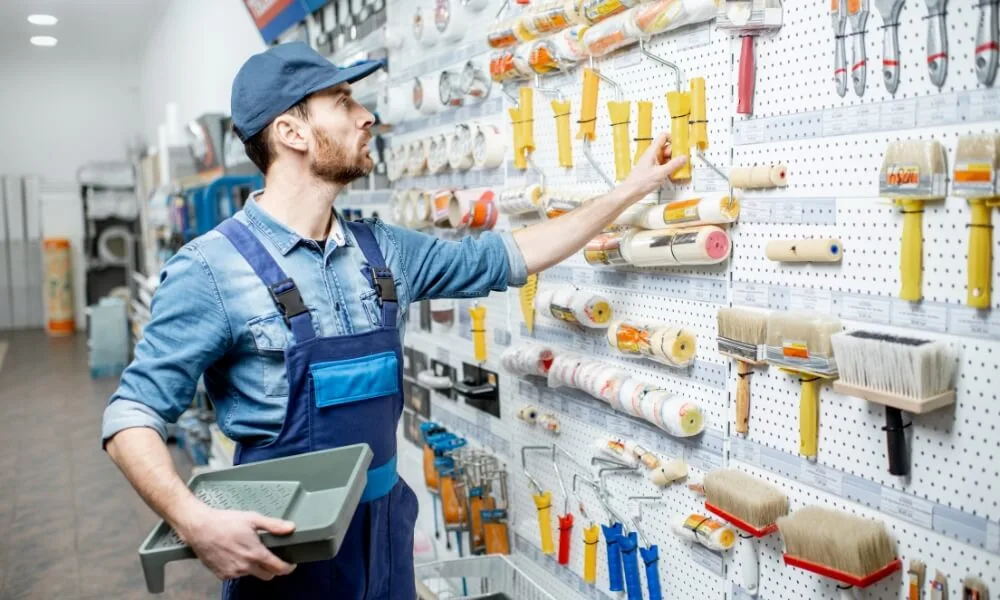How to Store Tools: Maximize Space & Efficiency
Are your tools scattered all over the place, making it hard to find what you need when you need it? You’re not alone.
Many of us struggle with keeping our tools organized, which can lead to wasted time and frustration. Imagine the satisfaction of having everything in its place, ready to grab at a moment’s notice. That’s not just a dream—it’s entirely possible with the right strategies.
In this guide, you’ll discover simple, effective ways to store your tools, whether you have a sprawling workshop or a compact toolbox. You’ll learn how to maximize your space, protect your investments, and enhance your productivity. By the end, you’ll be equipped with the knowledge to transform your tool storage, turning chaos into order. Ready to take control of your tools? Let’s get started.
Organize Your Workspace
Organizing your workspace is crucial for efficient tool storage. A clutter-free environment enhances productivity and safety. It helps you find tools easily. Proper organization also extends the lifespan of your tools. Start by evaluating the space you have. Then plan where each tool should go. Let’s explore these steps further.
Assess Available Space
Begin by examining the area you have for storage. Measure dimensions carefully. Identify unused corners or walls. Consider vertical spaces like shelving. Determine accessibility to stored tools. Make sure you can reach them without strain. Keep an eye on lighting conditions. Proper lighting ensures you can see tools clearly. Think about your workspace layout. It should support your workflow.
Plan Tool Layout
Decide how you want your tools arranged. Group similar tools together. This makes finding them quicker. Use pegboards for hanging frequently used tools. Label tool storage areas clearly. This avoids confusion. Consider storage containers for small items. Drawers can keep them organized. Ensure heavy tools are stored low. This prevents accidents. Plan a layout that suits your needs.
Tool Categorization
Organizing tools efficiently saves time and space. Proper categorization helps locate tools quickly. It also protects them from damage. This process involves sorting by function and grouping by frequency of use. Let’s explore each method.
Sort By Function
Arrange tools based on their purpose. Group similar tools together. For example, put all cutting tools in one section. This includes saws, scissors, and knives. Do the same for measuring tools. Keep rulers, tape measures, and calipers together. This method makes it easy to find the right tool.
Sorting by function creates a logical order. It enhances the efficiency of your workspace. Each tool has its rightful place. Maintenance becomes simpler and faster.
Group By Frequency Of Use
Keep often-used tools within easy reach. Store less-used tools further away. This reduces unnecessary movement. Frequently used tools should be accessible. Place them in front or on top shelves.
Tools used less often can go to the back. This grouping reduces clutter. It speeds up tasks and increases productivity. You will spend less time searching for tools.
Consider your daily tasks. Adjust tool placement accordingly. Frequent users should have priority. This ensures a smooth workflow.
Storage Solutions
Organize your tools efficiently by using pegboards for easy access. Stackable bins keep smaller items in place. Shelves and cabinets provide space for larger tools, ensuring everything is neat and visible.
Storing tools efficiently can transform your workspace. It not only maximizes space but also ensures you can find what you need when you need it. Whether you’re a seasoned DIY enthusiast or just getting started, the right storage solutions can make a world of difference. Let’s dive into some practical ideas that can help you organize your tools and keep your workspace clutter-free.Wall-mounted Racks
Wall-mounted racks are a game-changer for organizing tools. They free up floor space and keep your tools within arm’s reach. I remember installing my first wall rack; it was a simple steel bar with hooks. Suddenly, my garage felt twice as big. Consider the types of tools you have. Do you have a lot of hammers, screwdrivers, or wrenches? Wall-mounted racks with adjustable hooks can accommodate all these. You can even add a magnetic strip for smaller metal tools like pliers and wire cutters. Think about the height of your racks. Make sure they’re at a comfortable level for you. If you share the space, ensure it works for everyone. This small consideration can save a lot of backaches.Toolboxes And Cabinets
Toolboxes and cabinets are classic storage solutions. They offer mobility and security for your tools. A toolbox can be your best friend if you often move between job sites or different areas of your home. I once had a toolbox that doubled as a seat. It was fantastic for working on low projects and kept my tools right by my side. Look for toolboxes with compartments; they help keep small items organized. Cabinets, on the other hand, are perfect for stationary storage. If you have a dedicated workshop, consider investing in a cabinet with lockable doors. This provides peace of mind, knowing your tools are safe and dust-free.Drawer Systems
Drawer systems can bring a sense of order to chaos. They’re ideal for storing small to medium-sized tools and accessories. Imagine opening a drawer and seeing all your wrenches neatly lined up; it’s a satisfying sight. Label each drawer to save time searching. You’ll know exactly where everything is, and you can get to work faster. Drawer liners can also prevent tools from sliding around, keeping them in place. Think about the depth of your drawers. Too shallow, and you might not fit larger tools. Too deep, and smaller items could get lost. Finding the right balance can optimize your tool storage. Do you have a favorite method for storing your tools? Or maybe a tip that changed your workshop game? Share your insights in the comments below!
Credit: www.reddit.com
Innovative Space Savers
Innovative space savers can transform your workshop or garage. Efficiently storing tools makes them accessible and organized. These clever solutions help maximize space, even in small areas. Discover practical ideas that keep your tools tidy and ready for use.
Magnetic Strips
Magnetic strips hold metal tools securely. Attach them to walls for convenient access. This method keeps tools visible and easy to grab. Strong magnets prevent tools from falling, offering a reliable storage option. Install strips near workbenches for quick reach during projects.
Pegboards
Pegboards create versatile storage systems. Hang them on walls to hold various tools. Use hooks and pegs to customize your setup. This adaptability suits different tool sizes and shapes. Pegboards allow you to rearrange tools as needed. Maintain order and display tools neatly.
Overhead Storage
Utilize overhead storage for bulky items. Install racks on ceilings to store less-used tools. This frees up floor and wall space. Overhead storage keeps the area uncluttered. Ensure racks are sturdy and safe to prevent accidents. Access overhead tools with ladders or stools.
Safety And Accessibility
When it comes to storing tools, ensuring safety and accessibility is crucial. Keeping your tools organized can prevent accidents and make them easy to find when you need them. Imagine reaching for a wrench in a hurry and accidentally knocking over a heavy tool. Safety and accessibility go hand in hand, and with a few thoughtful strategies, you can keep your workspace secure and efficient.
Secure Heavy Tools
Heavy tools pose a risk if not stored properly. A sturdy pegboard or wall-mounted rack can be your best friend. Secure these tools by hanging them properly, ensuring they won’t fall off easily.
Think about the last time you needed a hammer quickly. Was it buried under other tools? By placing heavy tools on secure hooks, you prevent accidents and save time.
Another practical tip is using magnetic strips for metal tools. These strips can hold tools firmly, reducing the risk of them slipping off. Safety isn’t just about preventing accidents; it’s also about ensuring you can work efficiently.
Label And Color Code
Labels can transform your storage system. Imagine the ease of finding a tool when each drawer or shelf has a clear label. You won’t waste time rummaging through piles.
Color coding takes labeling a step further. Assign colors to different tool categories. For example, use red for electrical tools and green for gardening tools. This visual cue helps you identify the right tool faster.
Consider your own experiences: how often have you spent precious minutes searching for the right screwdriver? A simple label or color code could have saved you that time.
Ask yourself: is your current system as efficient as it could be? By implementing labeling and color coding, you enhance accessibility and streamline your workflow.

Credit: www.reddit.com
Maintenance And Regular Checks
Proper tool maintenance extends their lifespan and ensures efficiency. Regular checks prevent unexpected breakdowns. This practice saves time and money in the long run. Maintenance involves cleaning and inspecting tools. Consistency in these routines is key. Let’s dive into how to keep your tools in top shape.
Routine Tool Cleaning
Clean your tools after every use. Dirt and grime reduce their performance. Use a damp cloth to wipe them down. For stubborn spots, use mild soap and water. Dry them thoroughly to prevent rust. Store tools in a dry place. This prevents moisture build-up.
Inspect And Replace
Regular inspection identifies wear and tear early. Check for cracks, rust, or loose parts. Replace damaged tools immediately. Using faulty tools can be dangerous. Tighten any loose screws or bolts. Ensure all parts function properly. Keep a checklist of tool conditions. This practice ensures nothing gets overlooked.
Tech Solutions For Tool Management
Efficiently storing tools can enhance productivity in any workspace. Implementing tech solutions like digital inventory systems helps keep track of tools effortlessly. Smart shelves and automated storage units make organizing easier, ensuring tools are always accessible and neatly arranged.
In today’s fast-paced world, keeping track of your tools can be a daunting task. With technology, however, managing your tool collection can be simple and efficient. Let’s dive into some tech solutions that can transform how you store and manage your tools.Inventory Apps
Inventory apps are a game-changer for tool management. They allow you to digitally track your tools, including their location, usage history, and maintenance schedules. Imagine never having to wonder where your hammer went or when your drill last received maintenance. These apps often come with features like barcode scanning, making adding or checking tools a breeze. Some popular inventory apps also integrate with cloud storage, ensuring your data is safe and accessible from anywhere. Have you considered how much time you could save by having a digital inventory at your fingertips?Digital Labels
Digital labels are another innovative solution for tool management. These labels can provide real-time data about each tool’s status and history. You can attach them to your tools, and with a simple scan from your smartphone, you can access detailed information instantly. This can be especially useful in a shared workspace where tools frequently change hands. Digital labels can help prevent loss and ensure accountability. Imagine the peace of mind knowing exactly who last used a tool and when it was returned. Could digital labels be the missing piece in your tool management puzzle? By embracing these tech solutions, you can turn your tool storage from chaos into a well-organized, efficient system. How might these tools change the way you manage your collection?
Credit: storeagent.ai
Frequently Asked Questions
How Can I Organize My Tools Efficiently?
Organize tools by categorizing them based on their type and usage. Use pegboards, shelves, and toolboxes for easy access and visibility. Label each section to ensure quick identification. Regularly review and declutter your collection to maintain organization and efficiency.
What Are The Best Storage Solutions For Tools?
The best storage solutions include toolboxes, pegboards, and storage cabinets. Toolboxes are portable and versatile for small items. Pegboards offer wall-mounted storage for easy accessibility. Storage cabinets keep larger tools secure and organized. Choose solutions based on space and tool size.
How Do I Prevent Rust On Stored Tools?
Prevent rust by cleaning tools thoroughly before storage and ensuring they are dry. Use rust-preventive sprays or oils on metal parts. Store tools in a dry environment with controlled humidity. Consider using silica gel packs to absorb moisture and protect tools.
Can I Store Tools In A Garage?
Yes, you can store tools in a garage. Ensure the garage is dry and well-ventilated to prevent rust. Use shelves, cabinets, and pegboards to organize tools efficiently. Secure valuable tools in locked storage for added security. Regularly clean and maintain the garage environment.
Conclusion
Organizing tools can save time and space. Store them properly to avoid damage. Use shelves, pegboards, or toolboxes for neatness. Label everything clearly. Keep frequently used tools within easy reach. Clean tools before storing to extend their life. Prioritize safety by storing sharp tools securely.
A tidy workspace boosts efficiency. Regular checks help maintain order. Invest time in organizing for long-term benefits. Proper storage makes future projects smoother. A well-organized tool collection is a valuable asset. Remember, small efforts lead to big rewards. Keep your tools in top shape with these simple tips.






